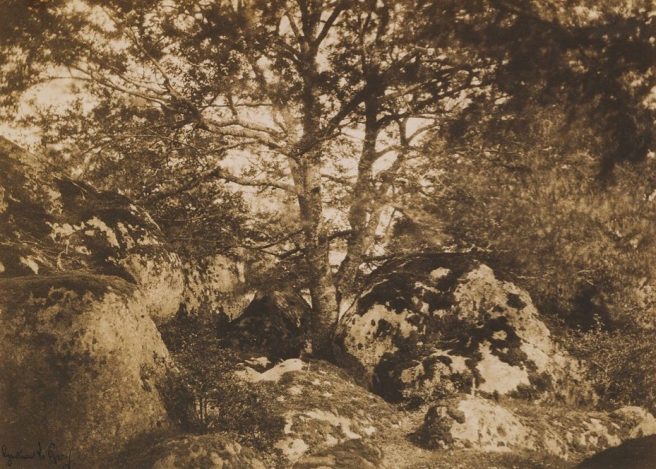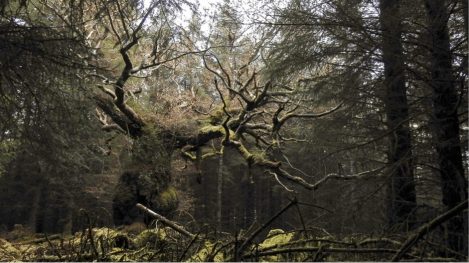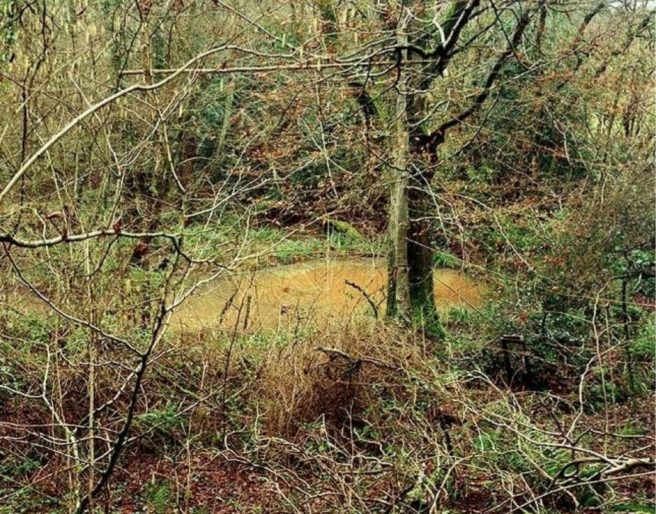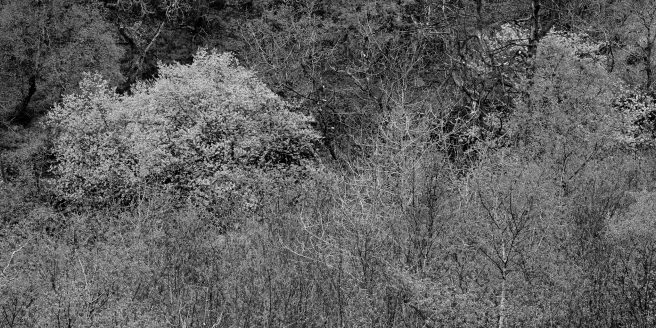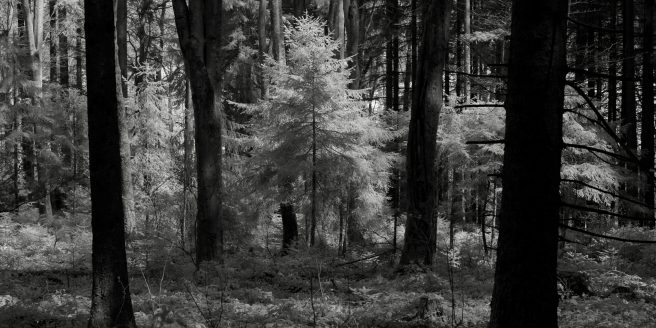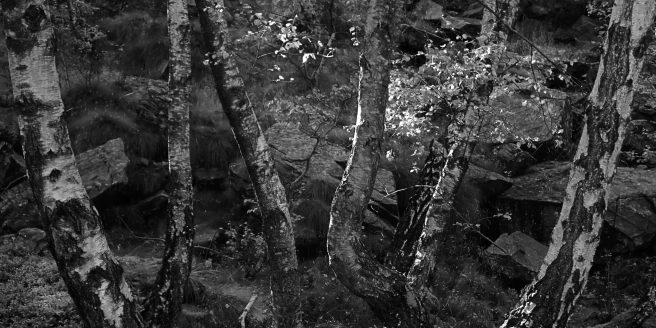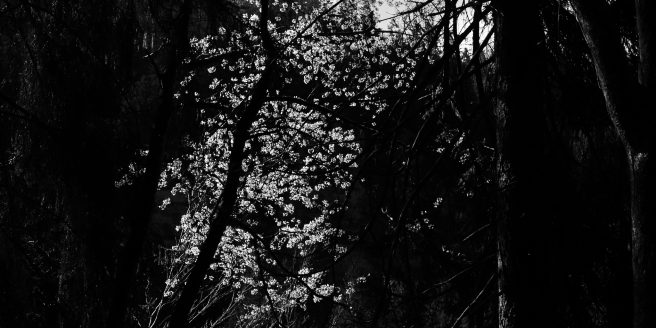Images from the Edge of the Forest

Keith Beven
Keith Beven is Emeritus Professor of Hydrology at Lancaster University where he has worked for over 30 years. He has published many academic papers and books on the study and computer modelling of hydrological processes. Since the 1990s he has used mostly 120 film cameras, from 6x6 to 6x17, and more recently Fuji X cameras when travelling light. He has recently produced a second book of images of water called “Panta Rhei – Everything Flows” in support of the charity WaterAid that can be ordered from his website.
I’ll declare an interest upfront: I like trees. Trees do good stuff for our environment, they lock up carbon, improve air quality, prettify our towns and cities, and support a myriad of animal and insect life. They also provide building materials, heat our homes and provide the paper for our books and currency… Without wood we would have no Stradivarius violins and cellos, and a host of other instruments. Many of our first infant sleeps are in wooden cots, and our final long sleep is in a wooden box. That’s why I like wood. And trees. And after five years apprenticeship, became a carpenter.” ~John McPherson, 20131
If you go back through the more than 300 issues of On Landscape (and the various volumes of the Natural Landscape Photography Award and Landscape Photographer of the Year), there are really rather a lot of images of trees2. Some highlights include the Eden valley trees in mist by Mark Littlejohn3; the images of the Fontainebleau forest by Francesco Carovillano4; the forests of the Taunus Mountains by Xavier Arnau Bofarull5; articles on the Scots Pine, Birch and Rowan trees by Tim Parkin himself6; the winter trees of Zion by Wayne Bingham7; and many others. Trees are also a frequently recurring subject in the 4x4 series; evidently, they are a pretty popular subject for many landscape photographers.
Looking more widely, photographic images of trees have a long history. A 2018 Exhibition at the V&A Museum in London (Into the Woods: Trees in Photography) was held to mark the 800th anniversary of the Charter of the Forest sealed in 1217 by King Henry III that restored access to forest lands that had been previously used exclusively as Royal Hunting Grounds8. The book of the exhibition9 provides a useful survey of images of trees from the very earliest days of photography. As early as 1857 the V&A staff photographer, Charles Thurston Thompson (1816-1868), was sent by the Director of the Museum, Henry Cole, to record images of the trees on his estate at Albury Park in Surrey. In the 1860’s Edward Fox (1823-1899) had been taking pictures of trees from the same point in different seasons. A catalogue of 183 images of different species of trees taken by Henry Irving10 were purchased by the V&A between 1899-1905. Such images were sold and made available in the V&A Library as a resource for artists, providing a basis for realistic illustrations. In France, the celebrated photographer Gustav le Gray (1820-1884) took images of trees at Fontainebleau11 as well as his well-known seascapes. As photography struggled to be recognised as an art form, the pictorialists (such as Alfred Stieglitz, Edward Steichen, C. H. White, A.L. Coburn, and William A. Cadby) often made extensive use of dark masses of trees and woods in their work.
Some trees have inevitably become somewhat stereotyped as images: the cherry blossoms in Japan13; the tunnel of twisted beech trees at Stranocum in County Antrim14; the dead black trees backed by immense sand dunes at Deadvlei in Namibia; the minimalism of winter trees standing in snow15; the ancient bristlecone pine trees in the White Mountains of California with trees up to 5000 years old16.
And talking of stereotypes, there are also the widely reproduced autumn/fall colours of the Aspens, particularly in Colorado and California18. Well-known Aspen photographers include Ansel Adams and John Sexton (in monochrome ) and Christopher Burkett and Peter Lik (in colour20) and, more recently, the On Landscape contributors Matt Payne21 and Charlotte Gibb22. There is also a recent Kozu book by Adam Gibb entitled Aspen23. The theme is so popular that guides to the best Aspen sites in Colorado and other states can be found on the Internet24. Back in the UK, books can be found describing exceptional trees25 as well as species guides. There is also, it seems, an award for tree of the year26.
Much has been written on the composition of taking images of trees. This requires reducing the three dimensional complexity of a tree or groups of trees to something that creates interest in 2 dimensions. Notable articles include those by Tim Parkin and Dav Thomas27 (who also produced the book With Trees28).
This can be seen in the works of single photographers, such as Lee Friedlander in his (monochrome) images in the books Flowers and Trees from 1981 and Frederick Law Olmstead Landscapes in 200829. While known for his innovative framing and composition Friedlander seems to revel in the complexity of mundane “thickets”, and it is sometimes difficult to see what might have attracted his eye in some of the images. Another notable photographer to revel in the complexity of groups of trees and thickets is Jem Southam in his Painter’s Pool series30.
There are now so many images of trees as a sub-genre of landscape photography that it could be argued that they have become a little boring, even if excellently lit and excellently framed and with mist in the background. However, I am hoping that this might perhaps be another example of how images that to many people would be seen individually as boring postcards might become more interesting as a series (see my first Boring Postcards article for On Landscape in Issue 31631). The Friedlander and Southam images are drawn from such series, even if individual prints have also been collected.
Thus, following such celebrated examples, I will take the risk of presenting another (and assuredly last!) series of Boring Postcards, this time in monochrome and taken at the edges of Swiss forests where there are often complex thickets but also areas where the trees and understory are actively managed.
There are many copses, woodlands and forests revealing their edges as the walker passes. This then results in a plethora of choices for such a series, and the need to decide on what makes a happy composition (especially when that mist is lacking!). In thinking about this there does not seem to be a simple answer but searching out compositions has the advantage that it can inspire focus on your surroundings as you walk32. Some have an element that stands out; others do not. Some have foreground interest and depth, others a rather flat plane. Some are rather complex, others have only relatively simple elements. It seems that indeed anything goes (or at least you can decide for yourself if any of the compositions work for you or whether, as with any collection of Boring Postcards, you just quickly swipe to the end). As before, this is only a selection of the images, more may be found here33.
References
- In comments on the exhibition Among Trees of the photographs of Iain Sarjeant as reported in issue 47 of On Landscape at https://www.onlandscape.co.uk/2012/10/an-exhibition-iain-sarjeant-among-trees/
- Searching on “trees” in On Landscape” brings up at least 500 results including Tim Parkin’s Composition Photographing Trees - https://www.onlandscape.co.uk/2011/05/composition-photographing-trees/
- E.g. https://www.onlandscape.co.uk/2015/08/an-approach-to-composition/; http://marklittlejohnphotography.com, especially the Secret Life of Trees and winter in the Eden Valley galleries
- https://www.onlandscape.co.uk/2023/12/voices; https://www.francescocarovillano.com
- https://www.onlandscape.co.uk/2023/11/where-the-trees-live/
- https://www.onlandscape.co.uk/2016/02/the-scots-pine ; https://www.onlandscape.co.uk/2016/09/birch-tree-landscape-photography; https://www.onlandscape.co.uk/2016/11/rowan-trees-photography/
- https://www.onlandscape.co.uk/2020/08/winter-trees-zion-national-park
- See the Wikipedia article at https://en.wikipedia.org/wiki/Charter_of_the_Forest#:~:text=The%20Charter%20of%20the%20Forest,in%20force%20for%20centuries%20afterwards.
- Book by Martin Barnes with the same title, V&A Publishing, 2019.
- Not much seems to be known about Henry Irving. The V&A cites records from the Royal Photographic Society that suggest that he lived in Lancashire in 1899 and moved south in the early twentieth century. He was based in Horley, Surrey, until around 1913, when he is recorded as living in Letchworth, Herts. He exhibited at the RPS between 1899 and 1915. He took many images of trees in the counties around London.
- For more about the history of Fontainebleau, see the 2017 article in On Landscape by Herbert Ascherman at https://www.onlandscape.co.uk/2017/05/forest-de-fontainebleau/
- For example, some of the images of Shinzo Maeda in his book Trees and Grass were published by Taschen.
- Known as the Dark Hedges and apparently now made famous by appearing as the King’s Road in the Game of Thrones series
- Such as those of Michael Kenna in Japan and Korea and the first part of the book by Abbas Kiarostami, Images Still and Moving, published by Hatje Cantz Verlag in 2012 https://www.hatjecantz.com/products/17198-abbas-kiarostami
- See https://en.wikipedia.org/wiki/Ancient_Bristlecone_Pine_Forest
- See https://en.wikipedia.org/wiki/Pando_(tree)
- According to Wikipedia, see https://en.wikipedia.org/wiki/Fortingall_Yew
- Searching for “aspen in fall images” results in 37,700 images on Istock and 14534 on Getty Images.
- For example, https://www.moma.org/collection/works/53646; https://www.moma.org/collection/works/50417 and the John Sexton book Listen to the Trees published by Bullfinch Press in 1994, http://www.johnsexton.com/Listen_to_the_Trees.html
- For example, https://www.onlandscape.co.uk/2021/10/christopher-burkett-radiant-mountain-aspen/
- https://www.onlandscape.co.uk/2022/01/matt-payne/; https://www.mattpaynephotography.com/gallery/aspen-tree-photos/
- https://www.onlandscape.co.uk/2017/06/charlotte-gibb/; https://www.onlandscape.co.uk/2017/05/endframe-dancing-aspen-charlotte-gibb; http://www.charlottegibb.com
- https://www.kozubooks.com/books-new/aspen
- For example, https://www.mickeyshannon.com/articles/colorado-fall-colors-photography-locations;
https://www.randybottphotography.com/gallery/colorado-fall-color; and even in Forbes magazine: https://www.forbes.com/sites/brittanyanas/2024/08/19/top-places-to-see-autumn-colors-in-colorado - E.g. https://harpercollins.co.uk/products/the-great-british-tree-biography-50-legendary-trees-and-the-tales-behind-them-mark-hooper?variant=39880371634254 ; https://shop.nationaltrust.org.uk/50-great-trees-of-the-national-trust.html ;
- The Skipinnish Oak was chosen by public vote from a shortlist of 12 organised by the Woodland Trust.
https://www.woodlandtrust.org.uk/trees-woods-and-wildlife/british-trees/tree-of-the-year. It is interesting to wonder how the votes might have been influenced by the images shown for each of the shortlisted trees (though there are no links from the shortlist to images now). The Woodland Trust also maintains an inventory of ancient trees in the UK (209,000 so far) for which submissions are invited. The Skipinnish Oak will represent the UK in the European Tree of the Year contest in 2025. - See Tim Parkin’s Composition: Photographing Trees (https://www.onlandscape.co.uk/2011/05/composition-photographing-trees) ; and Dav Thomas Seeing the Wood for the Trees (https://www.onlandscape.co.uk/2013/05/seeing-the-wood-for-the-trees);
- Dav Thomas, With Trees, published by Triplekite Publishers in 2013. (https://www.onlandscape.co.uk/2013/07/with-trees)
- Frederick Law Olmstead (1822-1923) was an American landscape architect famous for co-designing many well-known urban parks with his partner Calvert Vaux, including their first project of Central Park in New York see https://en.wikipedia.org/wiki/Frederick_Law_Olmsted. Lee Friedlander was first commissioned to photograph the parks in 1988 but continued the project for more than 20 years.
- Jem Southam, The Painter’s Pool, Nazraeli Press, 2007, see also https://hymancollection.org/bodies-of-work/jem-southam-the-painters-pool/
- https://www.onlandscape.co.uk/2024/11/boring-postcards
- See my article on walking at https://www.onlandscape.co.uk/2024/06/the-road-not-taken
- This is a Blurb print-on-demand book that can also be found via the https://www.blurb.co.uk/b/12206848-les-bords-de-la-for-t website. All the images can be previewed for free.

